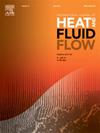圆柱绕流的被动流体控制
IF 2.6
3区 工程技术
Q2 ENGINEERING, MECHANICAL
International Journal of Heat and Fluid Flow
Pub Date : 2025-01-28
DOI:10.1016/j.ijheatfluidflow.2025.109750
引用次数: 0
摘要
边界层的吸力是延缓分离和减小外部气流阻力的有效手段。然而,如果需要一个泵送系统来产生吸力,那么系统的重量和功耗就会抵消这种好处。“自生”(自生)吸力控制是一种流动控制,它利用流动中的能量(特别是压力梯度)来驱动吸力,因此不需要向系统提供更多的能量。本文对二维层流范围内的圆柱绕流进行了数值研究:Re = 40(稳态)和Re = 120(非稳态)。吸气和吹气控制是通过施加速度边界条件实现的。然后使用优化方法对这些控制进行修改,以产生可由其压差(即Ps≥Pb)被动产生的吸入和吹气布置。进行了定常和非定常仿真。结果表明,在Re = 40和Re = 120时均可产生减阻安排。在Re = 120时,阻力降低4.3%,同时保持从吸力到吹气位置的正压差。这种开发被动吸力控制的方法可以应用于其他钝体流动和更高的雷诺数,以设计有效的优化流动控制,尽管具体的控制参数可能略有不同。本文章由计算机程序翻译,如有差异,请以英文原文为准。
Passive Fluidic control of flow around circular cylinder
Suction of the boundary layer is an effective means of delaying separation and reducing drag on external flows. However, if a pumping system is required to generate the suction, the weight and power consumption of the system can undo that benefit. ‘Autogenous’ (self-generating) suction control is a type of flow control that utilises the energy already within a flow (notably the pressure gradients) to drive the suction, thereby requiring no further energy to the system. This paper describes numerical studies that were performed on the flow around the circular cylinder in the 2D laminar range: Re = 40 (steady) and Re = 120 (unsteady). Suction and blowing control were implemented by imposed velocity boundary conditions. These controls were then modified using optimisation methods to generate arrangements of suction and blowing that can be passively generated by their pressure differential (i.e. Ps ≥ Pb). Steady and unsteady simulations were performed. It was found that at both Re = 40 and Re = 120 drag-reducing arrangements could be produced. At Re = 120 a reduction in drag of 4.3 % was found while maintaining a positive pressure differential from the suction to blowing loci. This approach for developing passive suction control can be applied to other bluff body flows and higher Reynolds numbers to design efficient optimised flow control although specifics of the control parameters may be slightly different.
求助全文
通过发布文献求助,成功后即可免费获取论文全文。
去求助
来源期刊

International Journal of Heat and Fluid Flow
工程技术-工程:机械
CiteScore
5.00
自引率
7.70%
发文量
131
审稿时长
33 days
期刊介绍:
The International Journal of Heat and Fluid Flow welcomes high-quality original contributions on experimental, computational, and physical aspects of convective heat transfer and fluid dynamics relevant to engineering or the environment, including multiphase and microscale flows.
Papers reporting the application of these disciplines to design and development, with emphasis on new technological fields, are also welcomed. Some of these new fields include microscale electronic and mechanical systems; medical and biological systems; and thermal and flow control in both the internal and external environment.
 求助内容:
求助内容: 应助结果提醒方式:
应助结果提醒方式:


